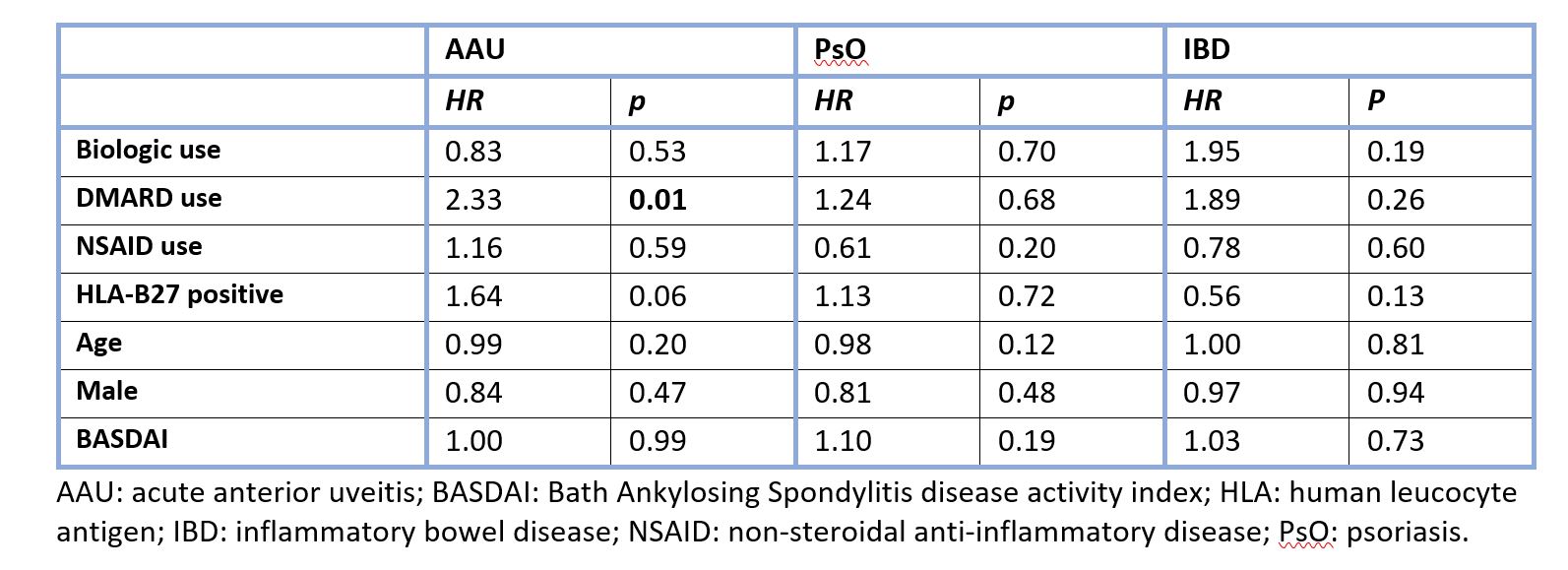Session Information
Date: Sunday, November 8, 2020
Session Type: Poster Session C
Session Time: 9:00AM-11:00AM
Background/Purpose: Axial spondyloarthritis (axSpA) patients have higher morbidity and mortality compared to healthy controls. Much of this excess disease burden is related to extra-articular manifestations (EAM) and comorbidities that may develop over time. Knowledge of predictive factors for the development of extra-spinal events in axSpA is limited by a dominance of cross-sectional studies in this area. This study aims to use real-world data to longitudinally analyse the risk factors for the development of extra-spinal events in axSpA.
Methods: This is a longitudinal observational cohort study, consisting of consecutive adult-onset axSpA patients (age of onset of axial symptoms ≥ 16 years) from July 2003 onwards. Patients were reviewed on a standard protocol every six months, with comprehensive documentation of demographics, clinical, laboratory and radiographic data. EAMs were defined as acute anterior uveitis (AAU), psoriasis (PsO) and inflammatory bowel disease (IBD). Time-to-event analysis, with time-weighted covariate exposure lagged by one year, was performed using R statistical package to assess the cumulative burden of extra-spinal events.
Results: Of the 1148 axSpA patients included in the study, 66% (n=757) were male and mean age was 40 (SD 12) years at study entry. AAU was present in 22% (n=246), IBD in 5% (n=55) and PsO in 4% (n=47) at baseline. After excluding these patients in the longitudinal analysis, AAU was the most frequent EAM to develop (see Figure 1) and was associated with the use of DMARDs (HR 2.28, p=0.01; Table 1). There was no impact of sex or disease activity on the development of any EAM. Hypertension was the most prevalent comorbidity at study entry (11%, n=120), followed by peptic ulcer disease (7%), depression (7%) and hyperlipidaemia (6%). The prevalence of ischaemic heart disease (IHD) was low (1.2%). Hypertension was the most frequent comorbidity to develop in follow-up (n=198), followed by depression (n=152) and hyperlipidaemia (n=128). IHD remained low (n=35). Age was the most common predictor for the development of a comorbidity (Table 2). Being male significantly increased the risk of hypertension (HR 2.61) and high cholesterol (HR 2.96), and was protective against fibromyalgia (HR 0.21). Time-averaged exposure analysis of medication usage showed an association between biologics and an increased incidence of hypertension (HR 2.35) and fibromyalgia (HR 6.5). NSAIDs (HR 2.15) were associated with an increased risk of hypertension (HR 2.15). A higher average BASDAI over the preceding five years significantly increased the risk of the development of sleep apnoea, depression and fibromyalgia.
Conclusion: To our knowledge, this is the largest longitudinal analysis of extra-spinal events in a real-world cohort of axSpA patients. Although overt IHD was uncommon, hypertension and high cholesterol were frequent. The traditional non-modifiable risk factors of age and male sex were associated with the development of cardiovascular comorbidity. Depression was associated with a higher average BASDAI in the five years preceding the diagnosis. Contrary to expectations, we saw no interaction between biologics and incidence of EAM.
 Figure 1: Incidence of Uveitis, Psoriasis and Inflammatory Bowel Disease
Figure 1: Incidence of Uveitis, Psoriasis and Inflammatory Bowel Disease
 Table 1: Regression analysis of predictors for the development of extra-articular manifestations over time.
Table 1: Regression analysis of predictors for the development of extra-articular manifestations over time.
 Table 2: Regression analysis of predictors for the development of comorbidities over time.
Table 2: Regression analysis of predictors for the development of comorbidities over time.
To cite this abstract in AMA style:
Fitzgerald G, Tomlinson G, Ramkissoon S, Wojcik S, Inman R, Haroon N. Time-dependent Analysis of Incident Extra-articular Manifestations and Comorbidities in Axial Spondyloarthritis [abstract]. Arthritis Rheumatol. 2020; 72 (suppl 10). https://acrabstracts.org/abstract/time-dependent-analysis-of-incident-extra-articular-manifestations-and-comorbidities-in-axial-spondyloarthritis/. Accessed .« Back to ACR Convergence 2020
ACR Meeting Abstracts - https://acrabstracts.org/abstract/time-dependent-analysis-of-incident-extra-articular-manifestations-and-comorbidities-in-axial-spondyloarthritis/
